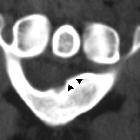posterior interosseous nerve syndrome

Posterior interosseous nerve syndrome is a compressive neuropathy of the posterior interosseous branch of the radial nerve, which affects the innervation of the forearm extensor compartment.
Epidemiology
Compressive neuropathies of the forearm are far less common than of the wrist, with radial nerve entrapment being the least frequent of the three major upper extremity nerves. Posterior interosseous nerve palsies are more common in males, with a reported ratio of 2:1 .
Clinical presentation
Posterior interosseous nerve syndrome will often have an insidious onset, presenting with weakness of the wrist and digital extensors. Active wrist extension will often result in radial deviation, due to preservation of the extensor carpi radialis longus, which is supplied by the radial nerve. This entity is usually painless, and patients with an isolated posterior interosseous nerve syndrome will not have a sensory deficit. This is a clinical feature useful in delineating this syndrome from radial tunnel syndrome.
Pathology
It is a result of posterior interosseous nerve compression from trauma, micro-trauma, space-occupying lesions or inflammation. The most commonly described sites of compression are the arcade of Frohse and the distal edge of the supinator muscle respectively . Other potential sites (proximal to distal) are:
- fibrous bands anterior to the radiocapitellar joint
- leash of Henry
- medio-proximal edge of the extensor carpi radialis brevis
Radiographic features
Plain radiograph
Radiography can assist in excluding underlying fractures, dislocations, instability or arthrosis as an underlying cause of compression.
Ultrasound
Ultrasound can be useful in both localizing and quantifying degree of constriction. The most commonly seen finding is posterior interosseous nerve enlargement or swelling at the proximal aspect of the compression site .
MRI
Imaging diagnosis based primarily on muscle denervation pattern; abnormal signal intensity or atrophy in muscles innervated by posterior interosseous nerve . MRI can also be used to identify any extrinsically compressive lesions, evaluate potential compression sites and ultimately for surgical planning if intervention is appropriate.
Treatment and prognosis
After excluding space-occupying lesions, initial treatment is conservative, involving rest, activity modification, splinting, physical therapy and NSAIDs. Prognosis is generally good with conservative measures.
In the context of a compressive lesion, surgical opinion is advised for consideration of excision. Surgical decompression is generally reserved for symptoms refractory to conservative management for >3 months and severe constriction. The operative treatments include; external and interfascicular neurolysis, neurorrhaphy and tendon transfer .
Differential diagnosis
Siehe auch:
- Nervenkompressionssyndrom
- Kompressionssyndrome
- Nervenkompressionssyndrome der oberen Extremität
- Nervus interosseus dorsalis
- Paralyse der Unterarmextensoren
und weiter:

 Assoziationen und Differentialdiagnosen zu Kompressionssyndrom Nervus interosseus dorsalis:
Assoziationen und Differentialdiagnosen zu Kompressionssyndrom Nervus interosseus dorsalis:

